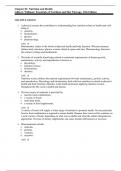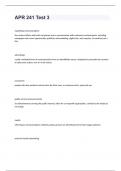Chapter 01: Nutrition and Health
Gilbert: Williams’ Essentials of Nutrition and Diet Therapy, 13th Edition
MULTIPLE CHOICE
1. A physical science that contributes to understanding how nutrition relates to health and well-
being is
a. anatomy.
b. biochemistry.
c. physics.
d. pharmacology.
ANS: B
Biochemistry relates to the whole of physical health and body function. Whereas anatomy
defines body structures, physics is more related to space and time. Pharmacology discusses
the science of drugs and medications.
2. The body of scientific knowledge related to nutritional requirements of human growth,
maintenance, activity, and reproduction is known as
a.physiology.
b.nutrition science.
c.biochemistry.
d.dietetics.
ANS: B
Nutrition science defines the nutrient requirements for body maintenance, growth, activity,
and reproduction. Physiology and biochemistry deal with how nutrition is related to physical
health and body function. Dietetics is the health profession applying nutrition science
throughout the life cycle in health and disease.
3. The best source of nutrients is provided by
a. specific food combinations.
b. a variety of foods.
c. individual foods.
d. a variety of food supplements.
ANS: B
A variety of foods will supply a wider range of nutrients to promote health. No one particular
food or food combination is required to ensure health. Humans have survived for centuries on
a wide variety of foods, depending on what was available and what the culture designated as
appropriate. Overuse of dietary supplements can cause nutrient deficiencies or excesses.
4. Macronutrients include
a. minerals.
b. proteins.
c. vitamins.
d. enzymes.
ANS: B
, Macronutrients are made up of carbohydrate, fats, and proteins. They supply energy and build
tissues. Minerals and vitamins (micronutrients) and enzymes are required in smaller quantities
and help to regulate body processes.
5. Micronutrients include
a. fats.
b. proteins.
c. vitamins.
d. carbohydrates.
ANS: C
Vitamins are nutrients that control and regulate cell metabolism. Fats, proteins, and
carbohydrates are macronutrients that supply energy to the body.
6. The sum of all chemical processes inside living cells of the body that sustain life and health is
known as
a. physiology.
b. digestion.
c. metabolism.
d. nutrition.
ANS: C
Metabolism is the overall process of how the body grows and maintains itself, breaks down
and reshapes tissue, and transforms energy to do its work. Digestion is the process of breaking
down food into absorbable substances that can be used by the body. Physiology is the study of
how nutrition relates to our physical health and body function. Nutrition is the sum of the
processes involved in taking in food, releasing the nutrients it contains, and assimilating and
using these nutrients to provide energy, maintain body tissue, and regulate body metabolism.
7. A primary function of macronutrients in the body is to
a. supply energy.
b. regulate metabolic processes.
c. maintain homeostasis.
d. control cellular activity.
ANS: A
The functions of nutrients in general are to provide energy, build and repair body tissues and
structures, and regulate the metabolic processes that maintain homeostasis. But macronutrients
are specifically responsible for supplying the body with energy and building tissue. Minerals
and vitamins are necessary for maintaining cellular activity.
8. Nutrients interact in the body to regulate metabolic processes, to build and repair tissue, and to
a. provide energy.
b. control cellular waste.
c. control hormone levels.
d. regulate absorption.
ANS: A
, The three general functions of nutrients are to provide energy, build and repair body tissues
and structures, and regulate the metabolic processes that maintain homeostasis. Water forms
the blood, lymph, and intercellular fluids that transport nutrients to cells and remove waste.
Proteins form vital substances such as enzymes and hormones that regulate body systems.
9. Some foods are sources of natural health-promoting substances known as
a. nutrigenomics.
b. phytochemicals.
c. metabolic factors.
d. macronutrients.
ANS: B
Phytochemicals are plant chemicals naturally found in fruits, vegetables, and whole grains and
have been found to play an active role in fighting chronic disease. Nutrigenomics is the study
of the interactions between the components in our diet and our genes. Macronutrients are
comprised of the three energy-yielding nutrients of proteins, carbohydrates, and fats. Specific
minerals and vitamins, along with water, are necessary for enzyme activities responsible for a
host of chemical reactions.
10. The nutrient group that provides the primary source of energy for the body is
a. carbohydrates.
b. fats.
c. proteins.
d. vitamins.
ANS: A
All three of the macronutrients—carbohydrates, fats, and proteins—can be used for energy,
but dietary carbohydrates (starch and sugars) are the primary sources of fuel for heat and
energy. Fats from animal and plant sources provide an alternate or storage form of energy. The
primary function of protein is tissue building, although this nutrient can be converted to
supply energy if needed.
11. The primary function of carbohydrates as a food source is to
a. regulate metabolic processes.
b. build body tissue.
c. supply energy.
d. provide bulk.
ANS: C
Complex carbohydrates supply necessary energy. The primary function of protein is tissue
building. Vitamins, minerals, and water are necessary for metabolic regulation.
12. The main body storage form of carbohydrates is
a. glycogen.
b. starch.
c. fat.
d. glucose.
ANS: A
, Glucose, the breakdown product of dietary carbohydrate, is the energy currency of the body.
Glycogen is the storage form of carbohydrate available for quick energy when glucose is
needed. Starch should be the major energy source in the diet. Fats provide an alternate storage
form of energy.
13. The number of kilocalories (kcalories or kcal) provided by a food that contains 30 g of
carbohydrate is
a. 90.
b. 120.
c. 180.
d. 270.
ANS: B
Carbohydrate has a fuel factor of 4.30 grams of carbohydrate 4 kilocalories per gram of
carbohydrate = 120 kcal.
14. The percentage of the total daily energy intake for healthy individuals that should be supplied
by carbohydrate is
a. 10% to 35%.
b. 20% to 35%.
c. 40% to 55%.
d. 45% to 65%.
ANS: D
Each gram of carbohydrate when metabolized in the body yields 4 kilocalories (kcalories or
kcal), known as its fuel factor. In a well-balanced diet for a healthy person, 45% to 65% of
total kcalories come from carbohydrate. The majority of these carbohydrate kcalories should
be obtained from complex carbohydrates (starch), with a smaller amount from simple
carbohydrates (sugars). For proteins, the range is 10% to 35%. For fats, the range is 20% to
35%.
15. It has been generally accepted that the percentage of total daily kilocalories supplied by fats
should be no more than
a. 10% to 15%.
b. 10% to 35%.
c. 20% to 35%.
d. 40% to 55%.
ANS: C
Fat is a more concentrated fuel than carbohydrate, with a fuel factor of 9, yielding 9 kcal/g.
Nutrition experts recommend that fats supply no more than 20% to 35% of total kcalories. For
proteins, the range is 10% to 35%. For carbohydrates, the range is 45% to 65%.
16. The number of kilocalories (kcal) provided by a food that contains 22 g of fat is
a. 88.
b. 132.
c. 154.
d. 198.
ANS: D
Fat has a fuel factor of 9.22 grams of fat 9 kilocalories per gram of fat = 198 kcal.





